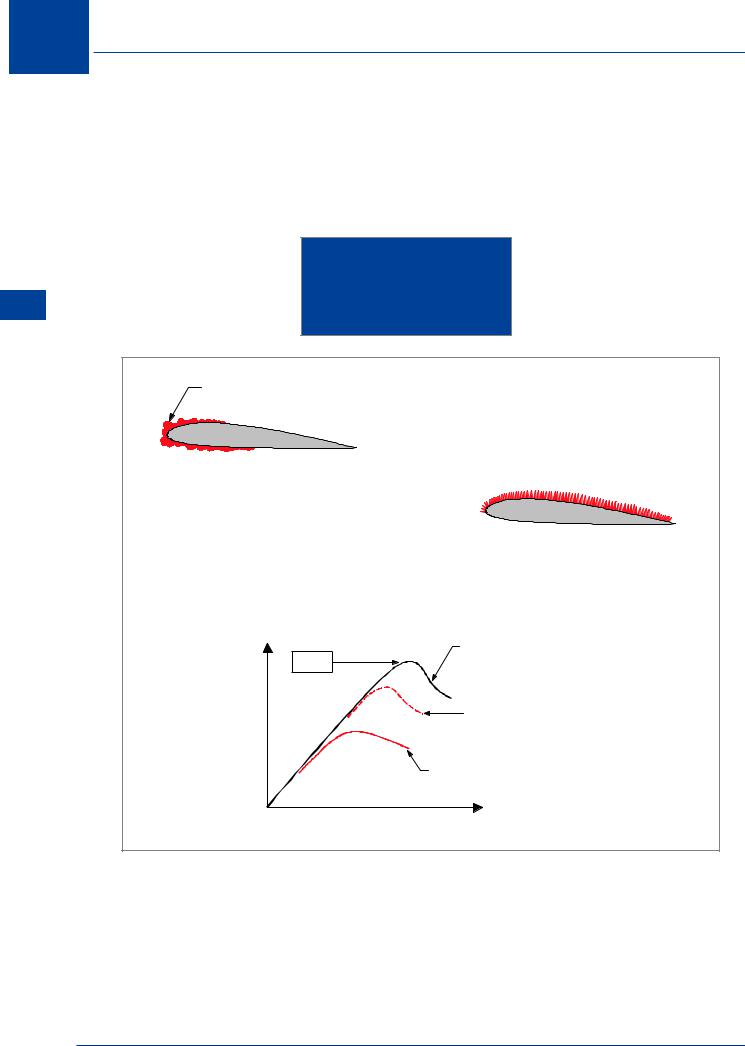
- •Textbook Series
- •Contents
- •1 Overview and Definitions
- •Overview
- •General Definitions
- •Glossary
- •List of Symbols
- •Greek Symbols
- •Others
- •Self-assessment Questions
- •Answers
- •2 The Atmosphere
- •Introduction
- •The Physical Properties of Air
- •Static Pressure
- •Temperature
- •Air Density
- •International Standard Atmosphere (ISA)
- •Dynamic Pressure
- •Key Facts
- •Measuring Dynamic Pressure
- •Relationships between Airspeeds
- •Airspeed
- •Errors and Corrections
- •V Speeds
- •Summary
- •Questions
- •Answers
- •3 Basic Aerodynamic Theory
- •The Principle of Continuity
- •Bernoulli’s Theorem
- •Streamlines and the Streamtube
- •Summary
- •Questions
- •Answers
- •4 Subsonic Airflow
- •Aerofoil Terminology
- •Basics about Airflow
- •Two Dimensional Airflow
- •Summary
- •Questions
- •Answers
- •5 Lift
- •Aerodynamic Force Coefficient
- •The Basic Lift Equation
- •Review:
- •The Lift Curve
- •Interpretation of the Lift Curve
- •Density Altitude
- •Aerofoil Section Lift Characteristics
- •Introduction to Drag Characteristics
- •Lift/Drag Ratio
- •Effect of Aircraft Weight on Minimum Flight Speed
- •Condition of the Surface
- •Flight at High Lift Conditions
- •Three Dimensional Airflow
- •Wing Terminology
- •Wing Tip Vortices
- •Wake Turbulence: (Ref: AIC P 072/2010)
- •Ground Effect
- •Conclusion
- •Summary
- •Answers from page 77
- •Answers from page 78
- •Questions
- •Answers
- •6 Drag
- •Introduction
- •Parasite Drag
- •Induced Drag
- •Methods of Reducing Induced Drag
- •Effect of Lift on Parasite Drag
- •Aeroplane Total Drag
- •The Effect of Aircraft Gross Weight on Total Drag
- •The Effect of Altitude on Total Drag
- •The Effect of Configuration on Total Drag
- •Speed Stability
- •Power Required (Introduction)
- •Summary
- •Questions
- •Annex C
- •Answers
- •7 Stalling
- •Introduction
- •Cause of the Stall
- •The Lift Curve
- •Stall Recovery
- •Aircraft Behaviour Close to the Stall
- •Use of Flight Controls Close to the Stall
- •Stall Recognition
- •Stall Speed
- •Stall Warning
- •Artificial Stall Warning Devices
- •Basic Stall Requirements (EASA and FAR)
- •Wing Design Characteristics
- •The Effect of Aerofoil Section
- •The Effect of Wing Planform
- •Key Facts 1
- •Super Stall (Deep Stall)
- •Factors that Affect Stall Speed
- •1g Stall Speed
- •Effect of Weight Change on Stall Speed
- •Composition and Resolution of Forces
- •Using Trigonometry to Resolve Forces
- •Lift Increase in a Level Turn
- •Effect of Load Factor on Stall Speed
- •Effect of High Lift Devices on Stall Speed
- •Effect of CG Position on Stall Speed
- •Effect of Landing Gear on the Stall Speed
- •Effect of Engine Power on Stall Speed
- •Effect of Mach Number (Compressibility) on Stall Speed
- •Effect of Wing Contamination on Stall Speed
- •Warning to the Pilot of Icing-induced Stalls
- •Stabilizer Stall Due to Ice
- •Effect of Heavy Rain on Stall Speed
- •Stall and Recovery Characteristics of Canards
- •Spinning
- •Primary Causes of a Spin
- •Phases of a Spin
- •The Effect of Mass and Balance on Spins
- •Spin Recovery
- •Special Phenomena of Stall
- •High Speed Buffet (Shock Stall)
- •Answers to Questions on Page 173
- •Key Facts 2
- •Questions
- •Key Facts 1 (Completed)
- •Key Facts 2 (Completed)
- •Answers
- •8 High Lift Devices
- •Purpose of High Lift Devices
- •Take-off and Landing Speeds
- •Augmentation
- •Flaps
- •Trailing Edge Flaps
- •Plain Flap
- •Split Flap
- •Slotted and Multiple Slotted Flaps
- •The Fowler Flap
- •Comparison of Trailing Edge Flaps
- •and Stalling Angle
- •Drag
- •Lift / Drag Ratio
- •Pitching Moment
- •Centre of Pressure Movement
- •Change of Downwash
- •Overall Pitch Change
- •Aircraft Attitude with Flaps Lowered
- •Leading Edge High Lift Devices
- •Leading Edge Flaps
- •Effect of Leading Edge Flaps on Lift
- •Leading Edge Slots
- •Leading Edge Slat
- •Automatic Slots
- •Disadvantages of the Slot
- •Drag and Pitching Moment of Leading Edge Devices
- •Trailing Edge Plus Leading Edge Devices
- •Sequence of Operation
- •Asymmetry of High Lift Devices
- •Flap Load Relief System
- •Choice of Flap Setting for Take-off, Climb and Landing
- •Management of High Lift Devices
- •Flap Extension Prior to Landing
- •Questions
- •Annexes
- •Answers
- •9 Airframe Contamination
- •Introduction
- •Types of Contamination
- •Effect of Frost and Ice on the Aircraft
- •Effect on Instruments
- •Effect on Controls
- •Water Contamination
- •Airframe Aging
- •Questions
- •Answers
- •10 Stability and Control
- •Introduction
- •Static Stability
- •Aeroplane Reference Axes
- •Static Longitudinal Stability
- •Neutral Point
- •Static Margin
- •Trim and Controllability
- •Key Facts 1
- •Graphic Presentation of Static Longitudinal Stability
- •Contribution of the Component Surfaces
- •Power-off Stability
- •Effect of CG Position
- •Power Effects
- •High Lift Devices
- •Control Force Stability
- •Manoeuvre Stability
- •Stick Force Per ‘g’
- •Tailoring Control Forces
- •Longitudinal Control
- •Manoeuvring Control Requirement
- •Take-off Control Requirement
- •Landing Control Requirement
- •Dynamic Stability
- •Longitudinal Dynamic Stability
- •Long Period Oscillation (Phugoid)
- •Short Period Oscillation
- •Directional Stability and Control
- •Sideslip Angle
- •Static Directional Stability
- •Contribution of the Aeroplane Components.
- •Lateral Stability and Control
- •Static Lateral Stability
- •Contribution of the Aeroplane Components
- •Lateral Dynamic Effects
- •Spiral Divergence
- •Dutch Roll
- •Pilot Induced Oscillation (PIO)
- •High Mach Numbers
- •Mach Trim
- •Key Facts 2
- •Summary
- •Questions
- •Key Facts 1 (Completed)
- •Key Facts 2 (Completed)
- •Answers
- •11 Controls
- •Introduction
- •Hinge Moments
- •Control Balancing
- •Mass Balance
- •Longitudinal Control
- •Lateral Control
- •Speed Brakes
- •Directional Control
- •Secondary Effects of Controls
- •Trimming
- •Questions
- •Answers
- •12 Flight Mechanics
- •Introduction
- •Straight Horizontal Steady Flight
- •Tailplane and Elevator
- •Balance of Forces
- •Straight Steady Climb
- •Climb Angle
- •Effect of Weight, Altitude and Temperature.
- •Power-on Descent
- •Emergency Descent
- •Glide
- •Rate of Descent in the Glide
- •Turning
- •Flight with Asymmetric Thrust
- •Summary of Minimum Control Speeds
- •Questions
- •Answers
- •13 High Speed Flight
- •Introduction
- •Speed of Sound
- •Mach Number
- •Effect on Mach Number of Climbing at a Constant IAS
- •Variation of TAS with Altitude at a Constant Mach Number
- •Influence of Temperature on Mach Number at a Constant Flight Level and IAS
- •Subdivisions of Aerodynamic Flow
- •Propagation of Pressure Waves
- •Normal Shock Waves
- •Critical Mach Number
- •Pressure Distribution at Transonic Mach Numbers
- •Properties of a Normal Shock Wave
- •Oblique Shock Waves
- •Effects of Shock Wave Formation
- •Buffet
- •Factors Which Affect the Buffet Boundaries
- •The Buffet Margin
- •Use of the Buffet Onset Chart
- •Delaying or Reducing the Effects of Compressibility
- •Aerodynamic Heating
- •Mach Angle
- •Mach Cone
- •Area (Zone) of Influence
- •Bow Wave
- •Expansion Waves
- •Sonic Bang
- •Methods of Improving Control at Transonic Speeds
- •Questions
- •Answers
- •14 Limitations
- •Operating Limit Speeds
- •Loads and Safety Factors
- •Loads on the Structure
- •Load Factor
- •Boundary
- •Design Manoeuvring Speed, V
- •Effect of Altitude on V
- •Effect of Aircraft Weight on V
- •Design Cruising Speed V
- •Design Dive Speed V
- •Negative Load Factors
- •The Negative Stall
- •Manoeuvre Boundaries
- •Operational Speed Limits
- •Gust Loads
- •Effect of a Vertical Gust on the Load Factor
- •Effect of the Gust on Stalling
- •Operational Rough-air Speed (V
- •Landing Gear Speed Limitations
- •Flap Speed Limit
- •Aeroelasticity (Aeroelastic Coupling)
- •Flutter
- •Control Surface Flutter
- •Aileron Reversal
- •Questions
- •Answers
- •15 Windshear
- •Introduction (Ref: AIC 84/2008)
- •Microburst
- •Windshear Encounter during Approach
- •Effects of Windshear
- •“Typical” Recovery from Windshear
- •Windshear Reporting
- •Visual Clues
- •Conclusions
- •Questions
- •Answers
- •16 Propellers
- •Introduction
- •Definitions
- •Aerodynamic Forces on the Propeller
- •Thrust
- •Centrifugal Twisting Moment (CTM)
- •Propeller Efficiency
- •Variable Pitch Propellers
- •Power Absorption
- •Moments and Forces Generated by a Propeller
- •Effect of Atmospheric Conditions
- •Questions
- •Answers
- •17 Revision Questions
- •Questions
- •Answers
- •Explanations to Specimen Questions
- •Specimen Examination Paper
- •Answers to Specimen Exam Paper
- •Explanations to Specimen Exam Paper
- •18 Index

Stalling 7
Effect of Wing Contamination on Stall Speed
Refer to:
AIC 106/2004 “Frost Ice and Snow on Aircraft”, and
AIC 98/1999 “Turbo-Prop and other Propeller Driven Aeroplanes: Icing Induced Stalls”.
Any contamination on the wing, but particularly ice, frost or snow, will drastically alter the aerodynamic contour and affect the nature of the boundary layer.
ICE The formation of ice on the leading edge of the wing will produce:
a)Large changes in the local contour, leading to severe local adverse pressure gradients.
b)High surface friction and a considerable reduction of boundary layer kinetic energy.
These cause a large decrease in CLMAX and can increase stall speed by approximately 30% with no change in angle of attack.
The added weight of the ice will also increase the stall speed, but the major factor is the reduction in CLMAX.
FROST The effect of frost is more subtle. The accumulation of a hard coat of frost on the wing upper surface will produce a surface texture of considerable roughness.
Tests have shown that ice, snow or frost, with the thickness and surface roughness similar to medium or coarse sandpaper on the leading edge and upper surface of a wing can reduce lift by as much as 30% (10% to 15% increase in stall speed) and increases drag by 40%.
While the basic shape and aerodynamic contour is unchanged, the increase in surface roughness increases skin friction and reduces the kinetic energy of the boundary layer. Separation will occur at an angle of attack and lift coefficients lower than for the clean smooth wing.
SNOW The effect of snow can be similar to frost in that it will increase surface roughness. If there is a coating of snow on the aircraft it must be removed before flight. Not only will the snow itself increase skin friction drag, it may obscure airframe icing. Snow will NOT blow off during taxi or take-off.
The pilot in command is legally required to ensure the aeroplane is aerodynamically clean at the time of take-off. It is very important that the holdover time of any de-icing or anti-icing fluid applied to the airframe is known. If this time will be exceeded before take-off, the aircraft must be treated again.
Stalling 7
179

7 Stalling
Stalling 7
While the reduction in CLMAX due to frost formation is not usually as great as that due to ice formation, it is usually unexpected because it may be thought that large changes in the
aerodynamic shape (such as due to ice) are necessary to reduce CLMAX. However, kinetic energy of the boundary layer is an important factor influencing separation of the airflow and this energy is reduced by an increase in surface roughness. The general effects of ice and frost formation on CLMAX is typified by the illustrations in Figure 7.31.
Ice, frost and snow change the aerofoil section, decrease the stall angle and increase the stall speed
LEADING EDGE ICE FORMATION |
UPPER SURFACE FROST |
BASIC SMOOTH WING |
C LMAX |
CL |
WING WITH FROST |
WING WITH ICE |
ANGLE OF ATTACK |
Figure 7.31
The increase in stall speed due to ice formation is not easy to quantify, as the accumulation and shape of the ice formation is impossible to predict. Even a little ice is too much. Ice or frost must never be allowed to remain on any aerodynamic surfaces in flight, nor must ice, frost, snow or other contamination be allowed to remain on the aircraft immediately before flight.
180

Stalling 7
Warning to the Pilot of Icing-induced Stalls
There have been recent cases involving loss of control in icing conditions due to undetected stalling at speeds significantly above the normal stalling speed, accompanied by violent roll oscillations.
Control of an aeroplane can be lost as a result of an icing-induced stall, the onset of which can be so insidious* as to be difficult to detect.
The following advice is offered on the recognition of, and the recovery from, insidious icinginduced wing-stalls:
|
|
7 |
a) |
Loss of performance in icing conditions may indicate a serious build-up of airframe icing |
Stalling |
|
(even if this cannot be seen) which causes a gradual loss of lift and a significant increase |
|
|
|
|
|
in drag; |
|
b) |
this build-up of ice can cause the aeroplane to stall at approximately 30% above the |
|
|
normal stall speed; |
|
c) |
the longitudinal characteristics of an icing-induced wing-stall can be so gentle that the |
|
|
pilot may not be aware that it has occurred; |
|
d) |
the stall warning system installed on the aeroplane may not alert the pilot to the |
|
|
insidious icing-induced wing-stall (angle of attack will be below that required to trigger |
|
|
the switch), so should not be relied upon to give a warning of this condition. Airframe |
|
|
buffet, however, may assist in identifying the onset of wing-stall; |
|
e) |
the first clue may be a roll control problem. This can appear as a gradually increasing |
|
|
roll oscillation or a violent wing drop; |
|
f) |
a combination of rolling oscillation and onset of high drag can cause the aeroplane to |
|
|
enter a high rate of descent unless prompt recovery action is taken; |
|
g) |
if a roll control problem develops in icing conditions, the pilot should suspect that the |
|
|
aeroplane has entered an icing-induced wing-stall and should take immediate stall |
|
|
recovery action (decrease the angle of attack). The de-icing system should also be |
|
|
activated. If the aeroplane is fitted with an anti-icing system this should have been |
|
|
activated prior to entry into icing conditions in accordance with the Flight Manual/ |
|
|
Operations Manual procedures and recommendations. If the anti-icing system has not |
|
|
been in use, then it should be immediately activated. Consideration should also be |
|
|
given to leaving icing conditions by adjusting track and/or altitude if possible. |
|
*Insidious - advancing imperceptibly: without warning
181

7 Stalling
Stalling 7
Stabilizer Stall Due to Ice
The tailplane is an aerofoil, and because it is thinner than the wing, it is likely to experience icing before the wing does. The effect will be the same as for the wing; the stall will occur at a lower angle of attack. The tailplane is normally operating at a negative angle of attack, producing a down load, so if the tailplane stalls and the down load is lost, the nose of the aircraft will drop and longitudinal control will be lost.
Stalling of an ice contaminated tailplane could be precipitated by extension of the wing flaps. Lowering the flaps increases the downwash, and this increases the negative angle of attack of the tailplane. If the tailplane has ice contamination, this could be sufficient to cause it to stall. Recovery procedure in this situation would be to retract the flaps again, thus reducing the downwash.
Effect of Heavy Rain on Stall Speed
Weight
Heavy rain will form a film of water on an aircraft and increase its weight slightly, maybe as much as 1 - 2% this in itself will increase stall speed.
Aerodynamic Effect
The film of water will distort the aerofoil, roughen the surface and alter the airflow pattern on the whole aircraft. CLMAX will decrease causing stall speed to increase.
Drag
The film of water will increase interference drag, profile drag and form drag. In light rain, drag may increase by 5%, in moderate by 20% and in heavy rain by up to 30%. This obviously increases thrust required.
Impact
An additional consideration, while not affecting stall speed, is the effect of the impact of heavy rain on the aircraft. Momentum will be lost and airspeed will decrease, requiring increased thrust. At the same time, heavy rain will also be driving the aircraft downwards. The volume of rain in any given situation will vary, but an aircraft on final approach which suddenly enters a torrential downpour of heavy rain will be subject to a loss of momentum and a decrease in altitude, similar to the effect of microburst windshear. (Chapter 15).
Stall and Recovery Characteristics of Canards
With the conventional rear tailplane configuration the wing stalls before the tailplane, and longitudinal control and stability are maintained at the stall. On a canard layout if the wing stalls first, stability is lost, but if the foreplane stalls first then control is lost and the maximum value of CL is reduced.
182
